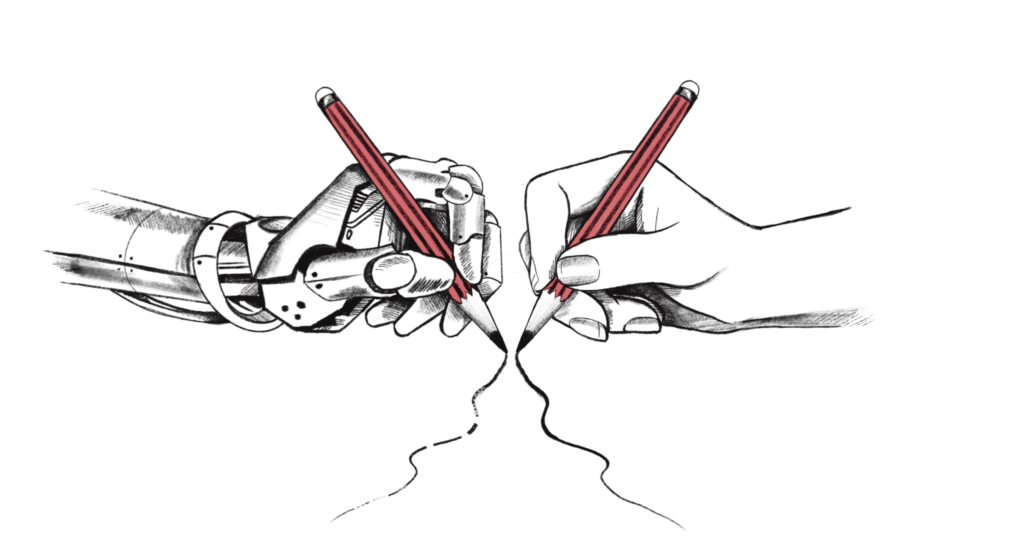With the rapid development of machine-learning, creators of high-quality content face new challenges in the shape of intellectual property and copyright protection. The primary concern becomes: who owns what when content is created via machine-learning?
Other concerns follow, such as:
- Who is the real artist and content creator?
- Can a non-human entity be granted copyright?
- Should it?
Intellectual property starts with an idea that becomes a copyrighted product. But it is difficult to pinpoint when ideas are “owned” by humans in the first place, much less when machine-learning is involved.
These questions are at an all-time high, with controversies unfolding in real time. But to understand these controversies, we must first understand the difference between copyright and intellectual property.
What is copyright protection and intellectual property?
The terms “copyright” and “intellectual property” are often used interchangeably.
This is a mistake.
Intellectual property refers to property that is a direct output of the human creative mind (1). On the other hand, copyright is only a small part of intellectual property. This is because intellectual property is an umbrella term that also includes trademarks and patents—alongside copyright.
Copyright is automatically granted to the creator of an originally created work in literature, art, music, design, software, etc. This means that an idea itself is not copyright-protected, but the expression of that idea is (1). The idea behind a movie is not copyrighted, but the movie in its entirety is. The “Star Wars” movies are copyrighted, for example, but the idea of a war among the stars is not. The same goes for a song. Or a software program.
Copyright can also be transferred in an exchange of licenses for financial gain (1). Copyright can be sold, essentially, while intellectual property cannot. This is the case when authors “sell away” the automatic copyright of their book to a publisher for the publisher to distribute the book for money.
The distinction between copyright protection and intellectual property is difficult for creators to maintain—even when machine-learning is not involved.
Can an AI legally be a content creator—should it?
At the heart of the matter, a battle exists between two values. Between human invention and technological innovation. Between human creativity and AI creation (2).
These values struggle to co-exist.
For instance, if an artificial intelligence cannot own intellectual property, we must ask ourselves whether that stifles technological innovation (3). We must choose between values. Between man vs. machine. And while this is no new battle, it has intensified in the wake of recent machine-learning development.
Governments are actively acknowledging the friction and seeking to solve it. For example, the UK Intellectual Property Office started an open consultation in 2021 that discussed whether AI-generated inventions should be protected (3).
But if an artificial intelligence can be granted legal copyright, what does that mean for humans? For their art and for their content?
Machine-learning affects the livelihood of human creators
If technology can replace all creators for free, then this lowers not only work opportunities for content creators, but also their monetary prospects for individual jobs (since they likely won’t be hired fulltime now that content can be created by machines).
It creates unsustainable living.
Machines have been replacing human labor ever since the industrialization of society. And yet technology has never come this close to replacing human thinking and thinkers as it is now. But there is an extra layer of threat when it comes to artificial intelligence replacing human creators.
This is the threat of The Uncanny Valley.
Japanese roboticist, Mashiro Mori, first identified the uncanny valley concept in the 1970s (4). A lot of horror media use the concept to scare audiences. It can be described as “the perception of not-quite-human entities by humans” (4). The human brain cannot comprehend creatures that look almost human, but not entirely. This is why a lot of people fear clowns, dolls, and taxidermy. And this might also be why people are fearful and resentful of machine-learning and AIs.
It is real, like us, but it is also not.
Moreover, this fear might even be the cause for recent copyright controversies.
AI-plagiarism in an art competition
In 2022, Jason M. Allen created an AI artwork via Midjourney, an artificial intelligence program. His piece won an annual competition in Colorado, making it one of the first AI-generated works to do so. His win was contested on the grounds of plagiarism (5). Midjourney is trained on copyright-protected data. It thus creates new art via that data…
… but is that legal? Or is that plagiarism?
A phone app scrapes artist signatures for content
The Lensa phone application also encountered plagiarism criticism in 2022. The application takes selfies and edits them into automated styles. The app scrapes and copies existing works from artists. Right down to their very signatures, in fact (6). A signature counts as copyright.
Without these artists’ consent, is Lensa plagiarizing their art by copying their signatures?
A book publisher “accidentally” uses AI art
The acclaimed book publisher, Tor, released a book cover in 2022 that was made with Midjourney. This is the same artificial intelligence that Jason M. Allen used for the Colorado art competition. Tor received major public backlash. They had a big budget and could pay a human creator. And yet they did not. This created concern for artists with lesser budgets. When Tor claimed to have used the art “by accident” and issued a public apology (7), they added fuel to the fire.
Chatbots overwhelm literary magazines with content
The award-winning literary magazine, Clarkesworld, announced in 2023 that it had seen an uptick in story submissions written by chatbots. From February 2020 to September 2022, the editor estimated the number of these chatbot-created stories to be 10. In the single month of February 2023 alone, he estimated 500 (8; 9).
Incidentally, this happened right around when ChatGPT went public.
But what does the international legislation say?
Both the European Patent Office and the United States Patent and Trademark Office produced guidelines last year to clarify what constitutes as patentable inventions in cases of artificial intelligence (2).
Overwhelmingly, the law within most EU jurisdictions only recognize the authorship of a human creator. Not creators who create software capable of generating a creation, nor artificial intelligence itself (10).
On the other hand, the US is ahead of the European Union in terms of acknowledging AI creatorship via copyright protection of content. While the US still has no copyright protection in place for works generated purely by an AI, copyright might be possible in cases where the creator can prove substantial human input (11).
In September of 2022, the US Copyright Office granted a “first-of-its-kind registration for a comic book generated with the help of text-to-image AI Midjourney” (11). While that decision is now being reviewed, the copyright has not yet been rescinded. One significant factor in the review is the degree of human input involved in creating the comic. This was also an argument for the contested Colorado art competition.
When copyrighting an AI’s output of content in the future, the decision will likely depend on the degree of human involvement (11).
Ways to compensate creators for their art and content
Alongside government legislation, private companies are also taking measures to compensate creators.
For example, Shutterstock plans to create a fund that compensates individuals whose work is sold to companies for training their machine-learning models. DeviantArt has also created a metadata tag for images that warns researchers of artificial intelligence to not scrape the original content (11).
This is not a solution, but it is a step towards one.
One other potential step would be to create databases where copyright infringement is impossible. Either because the data is licensed or created specifically for artificial intelligence training (11).
It seems clear that human creators need compensation when their copyrighted material is used to create new material. Specifically, if human creators are to have a sustainable livelihood.
It also seems clear that artificial intelligence needs more consideration as a creator on a legislative level. This is to create a clearer delineation between what human creators can expect for their art and content.
If human creators know what is legal for an artificial intelligence in terms of copyright protection and plagiarism, then they can adjust accordingly. They can control their own copyright protection of their content. If this comes to be, humans and machines might be able to create content together.
References
- Differences Between Copyright and Intellectual Property (2021, January 5). Aughton Ainsworth. https://aughtonainsworth.com/news/differences-between-copyright-and-intellectual-property/
- Gülen, K. (2022, October 4). Can an artificial intelligence-enabled invention be patented? Dataconomy. https://dataconomy.com/2022/10/intellectual-property-artificial-intelligence/
- Archer, P. (2021, December 10). AI Inventors: can AI own intellectual property rights? Raconteur. https://www.raconteur.net/technology/ai-intellectual-property-rights/
- Miller, A. (2022, October 17). How to use the Uncanny Valley in Horror. No Film School. https://nofilmschool.com/how-use-uncanny-valley-in-horror
- Erdine, Ö. (2022, September 26). AI wins art competition: Is imputing text prompts enough to become an artist? Dataconomy. https://dataconomy.com/2022/09/ai-artwork-wins-art-competition/
- Mattei, S. (2022, December 9). Artists Voice Concerns Over The Signatures In Viral Lensa AI Portraits. ARTnews. https://www.artnews.com/art-news/news/signatures-lensa-ai-portraits-1234649633/
- Codega, L. (2022, December 16). Tor Tried to Hide AI Art on a Book Cover, and It Is a Mess. Gizmodo. https://gizmodo.com/tor-book-ai-art-cover-christopher-paolini-fractalverse-1849904058
- Clarke, N. (2023, February 2). A concerning trend. Neil Clarke. http://neil-clarke.com/a-concerning-trend/
- Hern, A. (2023, February 21). Sci-fi publisher Clarkesworld halts pitches amid deluge of AI-generated stories. The Guardian. https://www.theguardian.com/technology/2023/feb/21/sci-fi-publisher-clarkesworld-halts-pitches-amid-deluge-of-ai-generated-stories
- Florea, F. (2022, September 6). Artificial intelligence and the future of IP rights. Wolf Theiss. https://www.wolftheiss.com/insights/artificial-intelligence-and-the-future-of-ip-rights/
- Vincent, J. (2022, November 15). The scary truth about AI copyright is nobody knows what will happen next. The Verge. https://www.theverge.com/23444685/generative-ai-copyright-infringement-legal-fair-use-training-data


